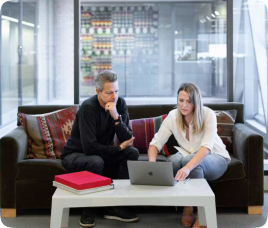Buying a Home
Buying a home is a significant decision and can seem overwhelming at first. However, breaking down the process into manageable steps can help streamline the process. Here are the general steps involved in buying a home:
Assess Your Finances
Determine how much you can afford to spend on a home. This involves assessing your income, savings, expenses, and credit score.
Pre-Approved for a Mortgage
Meet with lenders to get pre-approved for a mortgage. This will give you a clear idea of how much you can borrow and what your potential monthly payments will be.
Set Your Criteria
Decide on the type of home you want, including location, size, features, and amenities. Consider factors such as proximity to schools, work, transportation, and recreational activities.
Start House Hunting
Begin searching for homes that meet your criteria. You can use real estate websites, work with a real estate agent, attend open houses, or drive around neighborhoods to find potential properties.
Make an Offer
Once you’ve found a home you like, work with your real estate agent to make an offer. Your offer should include the purchase price, any contingencies, and a proposed closing date.Negotiate Terms
Be prepared to negotiate with the seller on the price and terms of the sale. This may involve multiple counter offers until both parties reach an agreement.Schedule Inspections
Once your offer is accepted, schedule a home inspection to identify any potential issues with the property. You may also want to arrange for additional inspections such as a pest inspection or radon testing.Finalize Mortgage Approval
Provide any additional documentation required by your lender to finalize your mortgage approval. This may include income verification, bank statements, and appraisals.Secure Homeowners Insurance
Obtain homeowners insurance to protect your investment. Your lender will require proof of insurance before closing.Closing Process
Attend the closing meeting to sign the necessary paperwork and finalize the purchase of the home. This includes signing the mortgage documents, transferring ownership, and paying closing costs.Move In
Once the closing process is complete, you’ll receive the keys to your new home. Plan your move and start settling into your new space.Make an Offer
Making an offer on a home is a crucial step in the home buying process. Here's a step-by-step guide on how to make an offer:
Understand the Market
Before making an offer, research the local real estate market to understand current trends, comparable sales, and the demand for homes in the area. This information will help you determine a reasonable offer price.
Work with a Real Estate Agent
A real estate agent can provide valuable guidance throughout the offer process. They can help you determine an appropriate offer price, draft the offer letter, and negotiate with the seller on your behalf.
Review Comparable Sales
Your real estate agent will help you review recent sales of similar homes in the area (comps). This information will give you a better understanding of the home's market value and help you decide on an offer price.
Consider Contingencies
Contingencies are conditions that must be met for the sale to proceed. Common contingencies include home inspections, appraisal, financing, and the sale of your current home. Discuss with your agent which contingencies are necessary for your offer.
Draft the Offer Letter
Your real estate agent will help you draft the offer letter, which includes details such as the offer price, requested contingencies, proposed closing date, and any other terms you wish to include. Make sure to carefully review the offer before submitting it.
Submit the Offer
Once the offer letter is finalized, your agent will submit it to the seller's agent or directly to the seller. The seller will then review the offer and decide whether to accept, reject, or counteroffer.
Negotiate Terms
Be prepared for negotiations with the seller. They may counter your offer with a different price or terms. Your agent will help you navigate the negotiation process and work to reach a mutually beneficial agreement.
Stay Flexible
Buying a home involves some degree of flexibility. Be prepared to compromise on certain terms to reach an agreement with the seller. Your agent can advise you on which concessions are reasonable to make.
Finalize the Agreement
Once both parties have agreed on the terms of the sale, the offer becomes a legally binding contract. Make sure to review the final agreement carefully before signing.
Closing Costs
Buyer closing costs are the expenses incurred by the buyer during the process of purchasing a home. These costs typically cover various fees and expenses associated with finalizing the real estate transaction. Here are some common buyer closing costs:
Buyer closing costs encompass the expenses incurred by the buyer during the final stages of a real estate transaction. These costs typically include various fees and charges associated with completing the purchase of a property. Examples of buyer closing costs may include loan origination fees, appraisal fees, title insurance, property taxes, homeowner’s insurance, and attorney fees. Additionally, buyers may also need to pay for inspections, surveys, and any prepaid expenses such as property taxes and homeowner’s insurance. The exact amount of closing costs can vary depending on factors such as the purchase price of the property, the location, and the specific terms of the purchase agreement. It’s essential for buyers to carefully review their closing disclosure statement provided by their lender and consult with their real estate agent or attorney to fully understand and prepare for these costs.




Earnest Money Deposit
An earnest money deposit serves as a tangible demonstration of a buyer’s genuine intent to purchase a property, signaling their commitment to the transaction. Typically provided when making an offer on a home, this deposit is a financial gesture of good faith toward the seller. Once submitted, the earnest money deposit is commonly held securely in an escrow account until the finalization of the real estate transaction, typically at closing. During this period, the deposit remains accessible to neither the buyer nor the seller, ensuring impartiality and safeguarding the funds until both parties fulfill their respective obligations. Understanding the role and significance of earnest money deposits is essential for both buyers and sellers embarking on real estate transactions, as they play a vital role in ensuring the integrity and trustworthiness of the buying process.
Purpose
The earnest money deposit shows the seller that the buyer is serious about purchasing the property.
Amount
The amount of earnest money deposit on factors such as customs, purchase price of home, negotiations between the buyer & seller.
Escrow Account
Upon acceptance of the offer, the earnest money deposit is usually held in an escrow account by a neutral third party.
Protection for the Buyer
If the sale falls through due to a contingency in the contract, the earnest money deposit is usually returned to the buyer.
Risk for the Seller
Accepting an earnest money deposit means the seller takes the property off the market while the transaction is pending.
Contingencies
Contingencies include satisfactory home inspections, appraisal, and financing.
Documentation
Documentation is typically included in the purchase agreement or a separate earnest money agreement.



